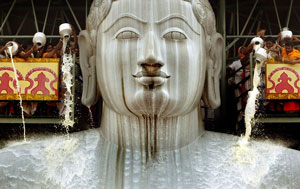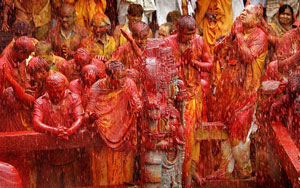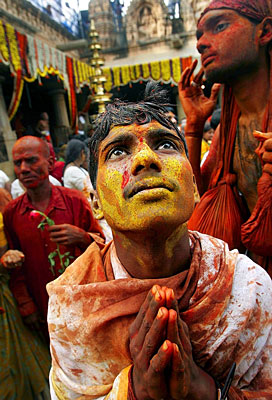Locating a festival in India is about as difficult as spotting a lunatic in New York City. Finding the once-every-12-years festival, Mahamastakabhisheka, where millions of devotees view the ritual bathing of a giant statue in vermillion, saffron, milk and tumeric, was a unique experience. Devotees from around the world flocked to witness the rare bathing of the 58-ft. statue of the Jain deity Gomateshwara, a Jain prince who renounced his kingdom and attained enlightenment. Gomateshwara is set at the summit of Vindhyagiri Hill in southern India and is billed as the world's largest monolithic statue.
 |
Jain devotees pour milk over the monolithic statue of Jain sage Gomateswara during the first day of the Mahamastak Abhisheka ceremony, Feb. 8, 2006. The ceremony officially runs February 8-19. Mario Tama/Getty Images |
On the first morning of the 11-day festival, as the sun rose behind Gomateshwara, I deposited my shoes at the base of the modest mountain because the entire hill is considered sacred, and trudged up the 614 steps carved into granite along with pilgrims. As I reached the summit and stood awed at the base of Gomateshwara's gargantuan carved feet. Naked Sadhus (ascetic monks) wandered seemingly in a trance as they performed puja (prayers) around Gomateshwara's giant toes. Thousands of devotees thronged and chanted at the base of the statue, patiently waiting their turn to ascend scaffolding and pour a bit of holy water over Gomateshwara's massive head. The devotees filed through a labyrinthine path of corridors and stairwells past overheated and occasionally menacing temple guards for hours before finally getting their chance to annoint the statue. As they reached the top of the scaffolding, the pilgrims giddily poured their small kalashas (urns) of holy water and tender coconut over the statue's head while appearing as mere specks in the sky to the teeming crowd below. The water rolled slowly down the face of Gomateshwara, providing just a hint of what was to come.
 |
Devotees are soaked in liquid vermillion as it is poured over the monolithic statue of Jain sage Gomateswara during the first day of the Mahamastak Abhisheka ceremony, Feb. 8, 2006, in Shravanabelagola, India. Mario Tama/Getty Images |
As the line of 5,000 devotees dwindled to an end after about four hours, the real ceremony began. The crowd buzzed in anticipation as rhythmic chanting and singing echoed across the summit. Suddenly a dozen or so giant kalashas of coconut milk were dumped by priests down over the statue from locations above the head and over each shoulder. The milk rapidly rolled down the length of the statue, transforming it into a surreal, multi-hued deity as the devotees danced in rapture below. The milk occasionally splashed off the statue outwards, drenching the elated pilgrims entranced near Gomateshwara's feet.
The priests above next appeared with large bowls and swiftly dumped a snowstorm of holy flour down over Gomateshwara and into the crowd, choking the sky and partially blotting out the sun as the flour danced down onto the spellbound crowd. The flour coated my lenses as devotees pulled clothing over their faces in the sandstorm-like melee.
 |
A Jain devotee prays after being soaked in liquid vermillion and saffron beneath the monolithic statue of Jain sage Gomateswara during the first day of the Mahamastak Abhisheka ceremony. Mario Tama/Getty Images |
The next kalashas were filled with liquid saffron which showered down Gomateshwara and onto the joyous devotees in a blizzard of yellow/orange rain. The soaked pilgrims danced and bounded through the downpour like children playing in the rain. Soon the kalashas were refilled, this time with a vermillion mixture. The red cascade flooded down on us as the ecstatic pilgrims raised their arms in the air, attempting to catch a drop of the crimson river. I did my best to dodge my cameras from the spray but they soon looked like something out of a Jackson Pollock painting with splatters of red and yellow. I was, thankfully, able to wipe the bright colors away. One joyous reveler scooped up a handful of the red-yellow goop and tossed it onto my back as I attempted to duck for cover. Pilgrims placed their hands together in prayer and gazed skyward at their revered idol representing the ideal of the Jain religion — renouncement of worldly desires and attainment of moksha (liberation or nirvana).
Monks and nuns sat stoically nearby and seemed to have their eyes locked skyward into the eyes of their hero. One Jain family told me they had traveled from Detroit to witness the spectacle of up to 3 million Jains (out of a total of 4-5 million) who were expected to attend at least a portion of the 11-day ceremony. As the vermillion shower came to an end, devotees were seen hauling large boxes of flowers up the scaffolding towards the top. Soon the statue was doused in a rainbow downpour of petals that ended on the outstretched arms of the pilgrims who consider catching a flower a holy moment.
Most of the flowers drifted down onto Gomateshwara's feet as devotees crowded towards the front attempting to pick one up. Priests passed the petals out to the enraptured crowd as the ceremony wound down. One woman placed a small bunch of flowers into my pocket, while assuring me in English that they would be auspicious. I walked back down the hill with the packed crowd of pilgrims as the sun set behind us. Gomateshwara was coated in a dazzling painting of streaked vermillion and saffron for the first time in 12 years, as were many of the devotees and at least a few photographers.
Mario Tama studied photojournalism at Rochester Institute of Technology, where he graduated with a BFA in 1993. He began shooting for the daily Journal Newspapers in suburban Washington, DC, from 1994-1998. From 1998-2001 he freelanced in Washington for The Washington Post and Agence France-Presse. In July, 2001, Mario joined Getty Images New York and has covered September 11th, the war in Afghanistan and the war in Iraq, among other global events.






